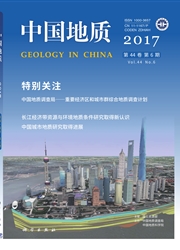

 中文摘要:
中文摘要:
笔者系统分析了1918-2005年间中国大陆及其周缘发生的3130个中、强地震的震源机制解,根据其特征进行了岩石圈应力场构造分区,首次得到区域应力场的压应力轴和张应力轴空间分布的统计数字结果。在此基础上研究了应力场的区域特征、探讨了其动力学来源以及构造运动特征。总体结果表明,中国大陆及其周缘岩石圈应力场和构造运动可以归结为印度洋板块、太平洋板块、菲律宾海板块与欧亚板块之间相对运动,以及大陆板内区域块体之间的相互作用的结果。印度洋板块向欧亚板块的碰撞挤压运动所产生的强烈的挤压应力,控制了喜马拉雅、青藏高原、中国西部乃至延伸到天山及其以北的广大地区。在青藏高原周缘地区和中国西部的大范围内,压应力P轴水平分量方位位于20-40°,形成了近NE方向的挤压应力场。大量逆断层型强震集中发生在青藏高原的南、北和西部周缘地区,以及天山等地区。而多数正断层型地震集中发生在青藏高原中部高海拔的地区,断层位错的水平分量位于近东西方向。表明青藏高原周缘区域发生南北向强烈挤压短缩的同时,中部高海拔地区存在着明显的近东西向的扩张运动。中国东部的华北地区受到太平洋板块向欧亚板块俯冲挤压的同时,又受到从贝加尔湖经过大华北直到琉球海沟的广阔地域里存在着的统一的、方位为170°的引张应力场的控制。华北地区大地震的震源机制解均反映出该区地震的发生大体为NEE向挤压应力和NNW向张应力的共同作用结果。台湾纵谷断层是菲律宾海板块与欧亚板块之间碰撞挤压边界。来自北西向运动的菲律宾海板块构造应力控制了从台湾纵谷、华南块体,直到中国南北地震带南段东部地域的应力场。地震的震源机制结果还表明,将中国大陆分成东、西两部分的中国南北地震带?
 英文摘要:
英文摘要:
The focal mechanism solutions of 3130 moderate and strong earthquakes occurred in continental China and its surroundings between 1918 and 2005 have been analyzed systematically, and according to their characteristics the tectonic divisions of the lithospheric stress field have been determined. The distribution of extensional and compressive axes was studied by statistics. The results suggest that the stress field of the lithosphere and tectonic movement in and around continental China are attributable to the motions of the Eurasian plate relative to the Indian, Pacific and Philippine Sea plates and interactions among blocks within the continental plate. The strong compressive stress due to collisions between the Eurasian and Indian plates dominated the movements from the Himalayas to Tianshan mountains in western China. Azimuths of the horizontal component of compressive stress P-axes likely lie between 20°and 40°, forming a nearly NE-directed stress field in the wide region west of the North-South Seismic Belt. Thrust type strong earthquakes occurred frequently along the edges of the Qinghai-Tibet Plateau and in the Tianshan region. Most normal fault type earthquakes are concentrated in the central Qinghai-Tibet Plateau with high altitudes. The horizontal component of the fault dislocation is oriented in an E-W direction. It implies that, simultaneously with the north-south strong compression and shortening in the Qinghai-Tibet Plateau and its surroundings, a nearly E-W-directed extensional motion apparently occurred in the high-altitude area of the central part of the plateau. Focal mechanism solutions in North China show that the earthquakes occurred under the combined action of the ENE compressive stress due to the subduction of the Pacific plate beneath the Eurasian plate and the NNW extensional stress in a unifying extensional stress field with a 170°azimuth in a vast region from Baikal Lake through North China to the Ryukyu Trench. The Longitudinal Valley fault of Taiwan is the boundary of collision
 同期刊论文项目
同期刊论文项目
 同项目期刊论文
同项目期刊论文
 期刊信息
期刊信息
